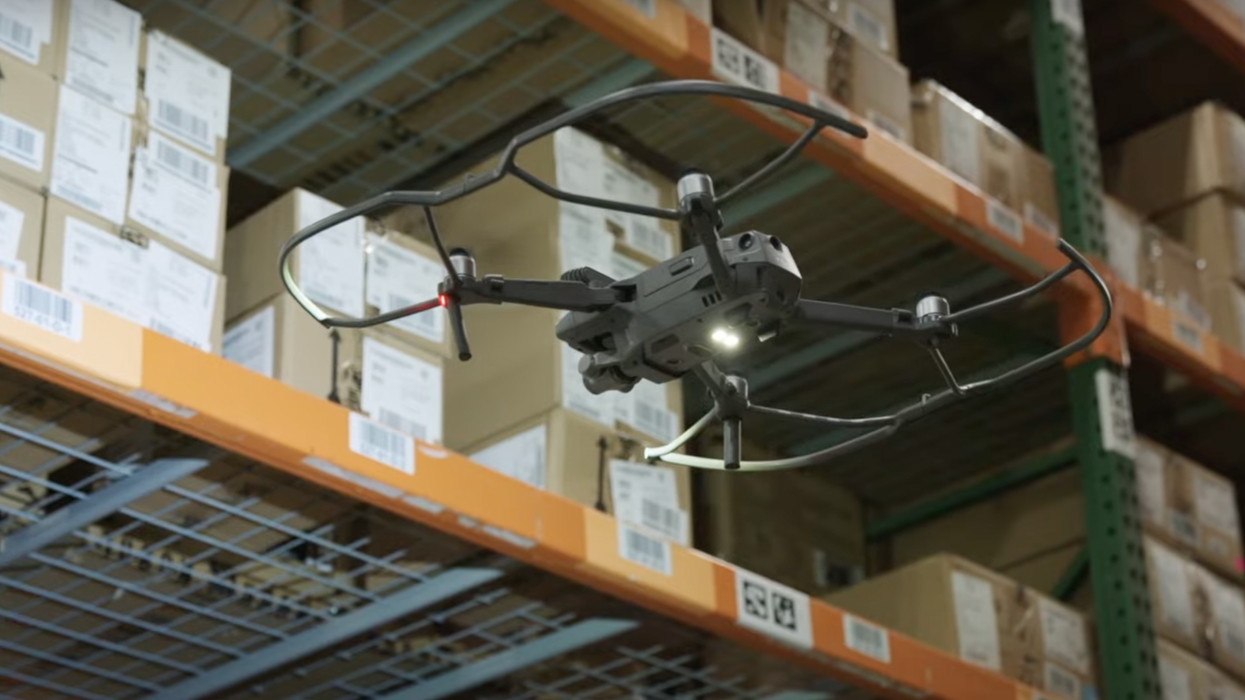Operations
16 March 2023
These drones are pinpointing lost inventory in warehouse stacks
Gather AI is deploying drones to help improve accuracy and speed within logistics operations.

(Photo via Gather AI)
Gather AI is deploying drones to help improve accuracy and speed within logistics operations.

(Photo via Gather AI)
Think of drones being used in ecommerce, and delivery probably comes to mind first. After all, Jeff Bezos’ famed 60 Minutes appearance in 2013 left a lasting vision of flying goods.
A decade later, a startup is showing that the last mile isn’t the only part of ecommerce logistics where autonomous aerial vehicles can make an impact.
Gather AI is deploying drones inside warehouses to help companies improve the accuracy of inventory counts, free up humans from repetitive labor and even locate inventory items that managers lost in the stacks. This week, the Pittsburgh-based company was named to the Retail Tech 100 from CB Insights, adding to a number of milestones over the last several years.
Founded out of Carnegie Mellon University’s famed robotics program by a team that was funded by DARPA to develop the first autonomous helicopter, Gather AI is applying the data collection capabilities of drones to inventory monitoring and asset gathering. During PhD work at CMU, CEO Sankalp Arora pursued a question at the center of how autonomous systems might interact with surroundings: How do you make drones curious?
“They were curious about landing zones, wires, openings in buildings and moving assets because my work was funded by the Department of Defense,” Arora said. “Now, my drones are curious about barcodes, boxes, racking and labels.”
Gather AI's drones are being used across multiple verticals of commerce, such as third-party logistics, retail distribution, manufacturing and food & beverage. Ahead of the company’s commercial launch in 2021, ecommerce emerged as a particular area that was rife with problems to solve. As fulfillment centers were getting bigger, the time required for humans with clipboards to count inventory only got longer. Additionally, the logistics space faced heavy labor attrition rates and even shortages, especially in the midst of the pandemic ecommerce boom.
“The warehouses were struggling to keep up,” Arora said. “Currently, our solution provides real-time inventory monitoring for those customers in warehouses nine to 15 times faster than current operations, and it is all visible and traceable, in real-time, with live photos.”

The drones fly between standing racks, using technology including robotics, computer vision and deep learning alongside cameras to map environments and collect data from the shelves. They run through an iPad, which provides monitoring and dashboards to review data. In one unique challenge among many that the company had to solve, there is no access to WiFi inside warehouses due to the metal construction, so the iPad and drones are connected.
The advancement of drones is an intriguing development for technologists, but for the people who run logistics operations, the question of their utility ultimately comes down to how it will help their business.
In some cases, these drones have been able to locate items after humans lost track of them. The company found 25,000 lost pallets for customers in 2022.
“It's misplaced inventory. It's not where it's supposed to be. It's somewhere in the warehouse. And as a result, if you get an order for that inventory, you don't get to pick it because you don't know where it is,” Arora said. “Now, we've found those and know exactly where they are, [so] they can fix their warehouse management system and start picking.”
That’s just one of the ways that the company said that drones improve inventory. Gather AI identified the following uses for warehouse drones, with stats from customers:
To fuel growth, Gather AI raised $17.5 million to date from investors, including a $10 million Series A in 2021, and now has 30 employees. It is looking to continue to grow not only its customer base, but the number of facilities it is flying through for those current clients. Each time the company started with a company in one facility, it has added others from that same company. Now, it is expanding capabilities to expand visibility and traceability through the warehouses in order to function as a complete network.
With customer deployments and results to report, Gather AI will be heading to Promat 2023 and the IWLA Convention in March.
The marketplace teamed with Techstars to support entrepreneurs charting the future of ecommerce.
Ecommerce marketplace eBay is teaming up with a national pre-seed investor to launch a new accelerator for startups building ecommerce technology.
The program, called Techstars Future of Ecommerce powered by eBay, will apply an accelerator model from Techstars that has supported thousands of companies to innovation that aims "to make selling and buying more equitable, attainable and sustainable,” according to eBay.
“Techstars has supported thousands of entrepreneurs that are using innovative technologies to transform industries,” said Collin Wallace, Managing Director at Techstars. “eBay’s expertise as an ecommerce pioneer paired with the programming, capital and connections that Techstars provides will create an unparalleled opportunity for founders.”
Here are key details about the program: